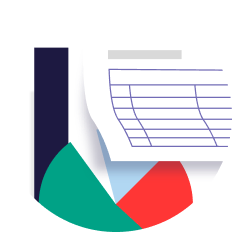As a mortgage broker, you know the power of the perfect match. You’re not simply connecting borrowers with loans, you’re helping them make life important decisions. The stakes are high, as the right loan can open the door to a dream home, while the wrong one can lead to financial strain and lost opportunities. But how to choose a loan program that will be a perfect fit for your client? That’s where your expertise and personalized approach come into play. You can make a difference by taking the time to deeply understand your clients’ financial situations, goals, and preferences. By thoroughly assessing these, you can make personalized loan recommendations that protect their financial well-being, reduce stress and confusion, and build lasting relationships. It sounds as simple as that, but it’s just theory. How does it work in practice? Let’s explore!
Understanding the Types of Loans
A whole bunch of mortgage loan types are out there today. And there is a reason for that. Each type has its features, benefits, and purpose. For instance, some are designed specifically for first-time homebuyers, while others are designed for investors. Therefore, knowing the main loan types and their characteristics is essential for a mortgage broker when it comes to the question, “How to choose a loan program?”
Here’s your quick guide to the major types of loans and what they entail.
Conventional Loans
Conventional loans are mortgages offered by private mortgage lenders and are not guaranteed or insured by the government. They are the most common type and offer competitive rates and terms. However, they typically require higher credit scores (usually 620 or higher) and larger down payments (at least 20%) than government-backed loans. In addition, a solid financial history and some savings may be necessary to qualify for such a mortgage.
This type of loan is ideal for borrowers with good credit, stable income, and some savings for a down payment.
Government Loans
Government loans are backed by the government and are offered by the Federal Housing Administration (FHA), the Department of Veterans Affairs (VA), and the United States Department of Agriculture (USDA). These mortgages come with advantages such as lower down payments and more flexible credit requirements compared to Conventional loans.
- FHA loans are available to all borrowers with lower credit scores (as low as 580 with a higher down payment). They also require a smaller down payment, typically just 3%, and have flexible underwriting guidelines. On the other hand, they typically have higher interest rates and require mortgage insurance premiums that place an additional financial burden on a borrower.
- VA loans are available exclusively to veterans, active duty service members, and their eligible spouses. A VA loan does not require a down payment, but qualifying military service is essential. They may also have specific property requirements.
- USDA loans are designed for low- to moderate-income families in certain rural and suburban areas. USDA loans offer 0% down payment options and are easy to qualify for. However, they come with income limits, require ongoing mortgage insurance premiums, and the property must be in an approved location.
If your client is a first-time homebuyer or has some credit bumps in the road, FHA loans can be a great option. A VA loan is suitable for active-duty military personnel, veterans, or eligible spouses with a history of service.
A USDA loan may be an option for low- to moderate-income families seeking homes in designated rural or suburban areas.
Second Mortgage
Second Mortgage:
Solutions for brokers!
- Up to 85% CLTV
- $500K max loan, up to 50% DTI
- No prepay penalties
Expand Your Offerings — Contact Us Today!
Discover Program
A Second Mortgage loan is a secondary loan taken out on a property that already has a mortgage. It provides access to additional cash without selling a property. This type of loan can be used for various purposes, such as home improvements or debt consolidation. However, to qualify for Second Mortgage, a portion of the outstanding equity, usually at least 20%, is required. What’s more, this mortgage typically comes with higher interest rates and shorter repayment terms. On top of that, a borrower should understand that it puts their home at risk if they can’t make the payments.
Second Mortgage may be an option for a borrower who owns a home with equity and needs additional cash for a specific purpose.
Hard Money Loan
Hard Money loans are asset-based and are secured by the property being purchased. Think of these as the “fast cash”, offering quick funding with minimal documentation. However, they come with the highest interest rates and the shortest terms. These are often used for investment properties or situations where traditional financing isn’t an option.
A Hard Money loan is a solution for someone who needs quick access to cash, has a non-traditional income source, and understands the high costs and risks involved.
Non-QM Loans
Non-qualified mortgage (Non-QM) loans do not meet the Consumer Financial Protection Bureau’s qualified mortgage requirements. They have flexible qualification requirements, can accommodate non-traditional income sources, and offer a variety of options to fit different situations. On the other hand, they come with higher interest rates and may require additional documentation or verification.
All of this makes Non-QM loans suitable for a wide range of borrowers, including the self-employed, investors, and those with non-traditional incomes, limited credit histories, or who don’t meet standard qualifying criteria.
Loan Term Options
Having expertise in loan types is not enough to find the perfect fit for a homebuyer. There is more to learn! Loan terms have a direct impact on a borrower’s financial obligations and long-term goals. Mortgage brokers should know the implications of different loan terms to tailor them to your client’s needs and ensure that the loan selected supports their financial well-being and homeownership objectives.
The choice between a 15-year or 30-year fixed-rate mortgage significantly impacts monthly payments and overall interest paid. A 15-year mortgage offers a shorter repayment period and lower overall interest rate but comes with higher monthly payments. A 30-year mortgage offers lower monthly payments but results in paying more interest over the life of the loan. Adjustable-rate mortgages (ARMs) initially offer lower interest rates than fixed-rate mortgages, but these rates can adjust periodically based on market conditions after an introductory period. While attractive for short-term affordability, ARM loans carry the risk of significantly higher payments in the future.
When helping clients select a loan term, it’s important to consider their long-term financial goals, budget, and overall debt management strategy. For example, borrowers planning for retirement may prefer a shorter loan term to pay off their mortgage sooner, while those focused on minimizing monthly payments may opt for a longer loan term. And if your clients expect to refinance or sell, they may consider ARMs. Refinancing the borrowers existing loan, may increase total finance charges over the life of the loan
Loan Rate Options
Similarly, being well-versed in loan rate options enables you to educate your clients about the implications of interest rate fluctuations and the potential risk associated with adjustable-rate loans. This can help you guide clients in selecting a loan with the most favorable rate structure based on their risk tolerance and financial stability.
Fixed-rate mortgages come with consistent interest rates and predictable monthly payments throughout the entire loan term, making budgeting easier and offering stability and peace of mind, especially in a volatile interest-rate environment. However, fixed-rate loans generally have a higher initial interest rate compared to the initial rate of an ARM.
ARMs typically offer lower initial interest rates, which can result in savings. They can be attractive for short-term affordability, especially if your client plans to sell or refinance before the introductory fixed-rate period ends. Some ARMs offer features like caps that limit how much the interest rate can adjust at each interval. On the other hand, interest rates may increase after the introductory period, potentially leading to significantly higher monthly payments. The ARM’s interest rate might also decrease, resulting in lower monthly payments. This can be beneficial, but it’s not guaranteed, and some ARMs have limitations on how much the rate can decrease. ARMs have less predictable long-term costs and require a higher level of risk tolerance, as future interest rate hikes may strain your client’s budget.
Key Factors Influencing Loan Program Selection
Struggling with
a loan scenario?
Get a solution in 30 minutes! Fill out
the short form and get your personal offer
Submit a Scenario
Some factors play a crucial role in determining the most suitable loan program for each borrower. These are credit score, down payment, DTI, employment and income, and even property location and type. Let’s take a closer look at each of these factors.
Credit Score
A credit score is a critical factor influencing both your client’s eligibility for a mortgage and the interest rates they’ll be offered. A strong credit score (typically above 620) opens doors to a wider range of loan programs, including Conventional loans with the most competitive rates and terms. A higher score also means less risk to the lender, resulting in a lower interest rate on a mortgage. This translates into significant savings over the life of the loan – a few percentage points difference in interest rate can amount to tens of thousands of dollars saved.
A lower credit score may limit a borrower’s eligibility to government-backed loans such as FHA loans (with a minimum credit score requirement of around 580) or require a higher down payment. As we’ve mentioned before, these loans often come with high interest rates and insurance requirements. In some cases, a borrower with a very low credit score may not qualify for a mortgage at all. What’s more, scores below 670 can result in higher interest rates.
Advising on how to improve credit scores through strategies such as paying bills on time, reducing debt utilization, and disputing errors can help your clients access the best possible options.
Down Payment
The size of the down payment directly affects loan eligibility and terms. A larger down payment acts as a “security deposit” for the lender, reducing their risk. They reward a borrower with better loan terms and access to more options. A smaller down payment means the lender takes on more risk. This can translate into higher interest rates, additional costs like PMI, and fewer loan options.
Exploring down payment assistance programs can help bridge the gap for first-time homebuyers or those with limited savings. These programs are often offered by government agencies, non-profit organizations, or even employers.
Debt-to-Income Ratio (DTI)
The DTI ratio is used by lenders to assess a borrower’s ability to manage monthly payments and repay the loan. It’s calculated by dividing the borrower’s total monthly debt payments by their gross monthly income. A lower DTI ratio is favorable and indicates that the borrower has a manageable level of debt with their income. Lenders generally prefer a DTI ratio below 43%. A high DTI ratio could limit the borrower’s loan options or result in higher interest rates, as it indicates a higher risk of default.
Implementing strategies to reduce debt, such as paying off high-interest credit cards or consolidating debt, can significantly improve a client’s loan eligibility.
Employment and Income Stability
Consistent income is critical to securing a mortgage, as lenders evaluate a borrower’s employment history and income stability to assess their ability to repay the loan. Some lenders may require additional documentation or verification for self-employed borrowers. For individuals with non-traditional incomes, discuss alternative mortgage programs such as Bank Statement, P&L, or Asset Utilization loans designed to accommodate their financial situation.
Asset Utilization:
Boost your client’s options!
- Minimum FICO 599
- Up to 80% CLTV
- Checking, savings, stocks, bonds
Grow Your Services with A&D Mortgage!
See Program Details
Property Location and Type
Property location and type can significantly impact loan program eligibility. Certain loan programs may have specific requirements or restrictions based on the property’s location and type. For example, rural areas may be eligible for USDA loans, while urban areas may have more options for Conventional or FHA loans. Additionally, certain property types, such as condominiums, may have specific requirements for financing. You can determine the right loan based on location and property type by having a clear idea of the various loan programs available and their respective eligibility criteria. You should be aware of any location-specific programs or incentives that may benefit your clients. Additionally, you can help clients select the loan program that best suits the specific property type they are interested in, taking into account factors such as condo associations, property conditions, and intended use.
Tips for Mortgage Brokers to Match Loans with Borrowers
Are you ready to sharpen your loan-matching skills now? Here are some mortgage broker tips on how to choose a loan program, for good measure.
1. Conduct a comprehensive financial analysis
This involves a comprehensive assessment of your client’s income, expenses, debts, and credit history. This analysis allows you to understand their overall financial picture and identify any potential challenges or opportunities.
2. Prioritize borrower goals and risk tolerance
Understand your client’s long-term financial aspirations and their comfort level with potential interest rate fluctuations. Some clients may prioritize affordability, while others may be willing to accept some risk for a lower initial rate.
3. Explain the pros and cons of each loan program
Provide clear and transparent information about different loan options, including eligibility requirements, interest rates, terms, and potential fees. Ensure your client understands the implications of each choice and how it aligns with their specific needs and goals.
4. Guide clients through the pre-approval and application process
Streamline the process by offering clear instructions and support throughout the application process. This includes helping them gather necessary documents, considering timelines, and addressing any questions or concerns they may have.
5. Stay updated on industry trends and loan program changes
Continuously expand your knowledge base to make sure you offer the most relevant and up-to-date solutions to your clients. This includes staying informed about changes in government regulations, interest rates, and new loan programs that may become available.
Conclusion
When it comes to mortgages, one size doesn’t fit all. That’s why a good mortgage broker is like a financial matchmaker, pairing borrowers with the best loan for their situation.
By having an eye for loan types and terms, rate options, credit score, down payment, DTI, income, and property, and strategically assessing your client’s financial situation, goals, and risk tolerance, you can find a loan that’s affordable and meets the borrower’s long-term goals. So don’t leave this important decision to chance!
At A&D Mortgage, our experts will walk you through every step of the process. Connect with A&D Mortgage today to find out how to choose a loan program for your clients and provide them with the financing solutions they deserve.







